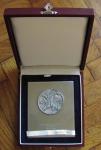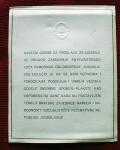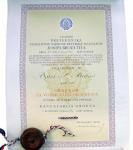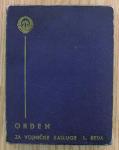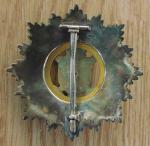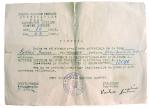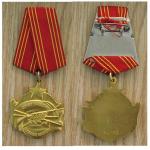
wlodzimierz
For Deletion-
Posts
559 -
Joined
-
Last visited
Content Type
Profiles
Forums
Blogs
Gallery
Events
Store
Everything posted by wlodzimierz
-
40 anniversary of session of ZAVNOH Plaque for participants of ZAVNOH sessions in 1944. The State Antifascist Council of the National Liberation of Croatia (ZAVNOH) (Croatian: Zemaljsko antifašističko vijeće narodnog oslobođenja Hrvatske) was the highest governing organ of the anti-fascist movement in Croatia during World War II. It was develop to be the bearer of Croatian statehood. At its last meeting, it changed its name to the National Parliament of Croatia, (Croatian: Narodni sabor Hrvatske). Sessions Initiative committee Preparations for the foundation of ZAVNOH started on December 5, 1942 when the Croatian representatives in AVNOJ requested the districtual boards to delegate members of the future Initiative Committee of the State Antifascist Council of National Liberation of Croatia. After the delegates were named the Initiative Committee was constituted in Ponori on March 1, 1943 near Brinje in Lika. 1st session Held June 13 (in Otočac) and June 14, 1943 (on Plitvice Lakes) was the founding session of ZAVNOH. Vladimir Nazor was chosen president. ZAVNOH adopted "Proclamation to Peoples of Croatia" ("Proglas narodima Hrvatske" in Croatian) and "Resolution" (often called "Plitvice Resolution"). Resolution stated that ZAVNOH was highest political authority of anti-fascist movement in Croatia. Executive board ("Izvršni odbor" in Croatian, abbr. IO ZAVNOH) of 11 members was elected to perform duties of ZAVNOH between sessions. As the representative of the Allied Command major William Jones (Lawrence of Yugoslavia) was present at the founding session. Also the representative of the Liberation Front of the Slovenian People, Jana Jernej was present. 2nd session The second session was held October 12 - October 15, 1943 in Plaški. In this session an executive board of 15 members was elected and the decision of Executive Board of ZAVNOH made on September 20, 1943 was confirmed. "Ordinance About Interior Organisation and Work of ZAVNOH" was adopted as well as the Secretariat of ZAVNOH was founded; which ruled Croatian affairs as a de facto government. 3rd session The third session occurred on May 8 and May 9, 1944 in Topusko, and was sometimes referred to as the Sabor u Topuskom ("Assembly in Topusko"). The third session of ZAVNOH formally formed the Federal State of Croatia. Newly adopted "Rules of conduct of ZAVNOH" disbanded IO (Executive Board) and formed 31 member Presidium of ZAVNOH. The following were established at this session: Authorization of Croatian delegates on the 2nd AVNOJ meeting to represent CroatiaProclamation of ZAVNOH as the supreme legislative and executive organ of government of Federal State of CroatiaDeclaration of basic rights of peoples and citizens of the Federal State of Croatia:The Croatian and Serbian people in Croatia are equal in every way. The National minorities in Croatia will have guaranteed human rights.All citizens of Croatia are equal in the eyes of the law, regardless of their nationality, race and religionWomen have the same rights as menEvery citizen is guaranteed personal and property security. The right of ownership and private initiatives are guaranteed. Decision about structure and operations of NOOs and assemblies in Federal State of CroatiaRules of conduct of ZAVNOH 4th session The final session occurred on August 21, 1945 in Zagreb (in building of Croatian Parliament). Here, ZAVNOH changed its name to the "People's Parliament of Croatia". ZAVNOH between sessions On September 20, 1943 Executive Board of ZAVNOH issued decision to return Istria, Zadar, Cres, Lastovo and other parts of Croatia which were ceded to fascist Italy by Independent State of Croatia. ZAVNOH operated in the City of Šibenik from December 31, 1944 to May 13, 1945, before moving to Zagreb on May 20, 1945. First People's Government of Croatia (led by Vladimir Bakarić) was founded at the extraordinary session of the Presidency of ZAVNOH, which was held on April 14, 1945 in Split. Constitution of Croatia on ZAVNOH Article 1 of the Constitution of the Republic of Croatia stated: The millenary identity of the Croatia nation and the continuity of its statehood, confirmed by the course of its entire historical experience within different forms of states and by the preservation and growth of the idea of a national state, founded on the historical right of the Croatian nation to full sovereignty, manifested in: [...] establishing the foundations of state sovereignty during the course of the Second World War, by the decisions of the Antifascist Council of National Liberation of Croatia (1943), as opposed to the proclamation of the Independent State of Croatia (1941), and subsequently in the Constitution of the People's Republic of Croatia (1947) and all later constitutions of the Socialist Republic of Croatia (1963-1990)[...] Source: http://en.wikipedia.org/wiki/ZAVNOH
-
Plaque: 40 anniversary of 2nd session of AVNOJ Plaque awarded by Parliamant of SFRJ to participant of 2nd session of AVNOJ. As far I know, this plaque was awarded for alive participants of 2nd session of AVNOJ in 1983. If this information is correct than the quantity of such plaques is very limited.
-
25 anniversary of 2nd session of AVNOJ. 142 high military and political personnel participated at 2nd session of AVNOJ. This plaque was given by Yugoslav Parliament to participants of that session. This plaque with #13, was given to Boris Balas. There are information that 270 such plaques was awarded. Second Session of the AVNOJ AVNOJ Proclamation of what will later become SFRJ In its second AVNOJ conference in the Bosnian town of Jajce, from November 21 to November 29, 1943, Tito declared AVNOJ to be the superior executive authority. The decisions and the resolutions of the second AVNOJ conference were: to create a federal Yugoslavia, based on the right of self-determination of nations, in which the southern Slavic peoples (Serbs, Croats, Slovenes, Montenegrins and Macedonians) who would live in six constituent republics with equal rights[1];to stress that even during the War of National Liberation there had been established anti-fascist councils of the national liberation of Yugoslav lands for Serbia, Croatia, Slovenia, Bosnia and Herzegovina, Sandžak, Macedonia, and Montenegro and the Bay of Kotor as the organisations of the people's administration of the land;to elect the National Committee of the Liberation of Yugoslavia (Nacionalni komitet oslobođenja Jugoslavije, NKOJ), based in Jajce, to act as the temporary government;to name Tito, Marshal of Yugoslavia and Prime Minister;to revoke the Yugoslavian government-in-exile; andto deny King Petar II Karađorđević's return to the country, until a popular referendum had been held on the status of the monarchy. Stalin, the Soviet leader, was enraged when he found out that he was not being informed of the November meeting, and reportedly barred Tito from declaring AVNOJ as a provisional government. The Western Allies, however, were not alarmed, because they knew that the Partisans were the only Yugoslav resistance group actively fighting the Germans. In December 1943, Roosevelt, Churchill, and Stalin decided to support the Partisans. The United Kingdom joined a month later, and stopped supplying the Chetniks. The first Soviet mission arrived at Partisan headquarters, shortly thereafter. The United States kept a military mission with Mihajlović to encourage continued Chetnik aid for downed American fliers. In May 1944, German airborne forces attacked Tito's headquarters in Drvar, nearly capturing him. Tito fled to Italy, and established a new headquarters on the Adriatic island of Vis. After throwing its full support to the Partisans, Britain worked to reconcile Tito and Petar. At Britain's urging, Petar agreed to remain outside Yugoslavia, and in September, summoned all Yugoslavs to back the Partisans. Source: http://en.wikipedia....on_of_the_AVNOJ
-
Gents, new discoveries during my last photo safari in Zagreb, I was able to make some photos of interesting set of awards and documents of Boris Balas. Boris Balaš Commander of Karlovac assault brigade of Yugoslav partisans and participant of 2nd session of AVNOJ and sessions of ZAVNOH. Karlovac assault brigade of Yugoslav partisans History Command of 4th Corps of Yugoslav partisans issued Order no.4 on 27 February 1944 for formation of Karlovac brigade. Brigade formed for the first time in the morning of 5 March 1944 in village Hrašće in front of house and mixed goods store of Ivan Latin. On the day of the forming brigade had 640 soldiers. On 25 November brigade had 1211 soldiers, according to national and social status: 1115 Croats 51 Serbs 17 Slovenians 2 Montenegrins 23 Muslims 1 Russian 2 Czechs 201 workers 806 farmers 33 intellectuals 115 merchants 51 clerks and high school pupils 5 military personnel Until end of the war Karlovac brigade suffered 337 killed, 442 wounded, 18 died from diseases and 107 missing out of which 30 captured. It inflicted 1739 casualties on the enemy out of which 722 killed, 457 wounded and 560 captured. Brigade staff Brigade commanders Franjo Molek from 5.3. to 30.6.1944. Boris Balaš from 8.7.1944. to 10.3.1945. Sulejman Suljo Vascarac from 12.3. to 26.4.1945. Boris Balaš from 26.4.1945. to end of the war Brigade political commissars Petar Erdeljac from 5.3. to 9.11.1944. Rafko Rafael Tabor from 9.11.1944. to end of the war Political commissars assistants Rafko Rafael Tabor from 5.3. to 9.11.1944. Janko Furdek from 20.11.1944 to 7.3.1945. Ivan Katušić from 10.3.1945. to end of the war Brigade chieff of staff Ivan Graho from 20.6. to 25.8.1944. Rade Škljac from 28.8. to 10.12.1944. Simo Miščević from 15.12.1944. to end of the war References Josip Lulik Pepo, Đuro Zatezalo: Karlovačka udarna brigada Source: http://www.vojska.ne...oatia/karlovac/
-
Yugoslavia Uspomena Sa Proslave
wlodzimierz replied to wlodzimierz's topic in Southern European & Balkan States
I think too that this is a kind of souvenir. Thank you Valter:cheers: -
Yugoslavia Uspomena Sa Proslave
wlodzimierz replied to wlodzimierz's topic in Southern European & Balkan States
-
Gents, I found this item but unfortunately I have no idea what could it be. This decoration has diameter of 25mm also it has size of miniatures. Manufactured in low quality, this leads me to the conclusion that it was mass decoration during the celebration of '30 Years of Victory over Fascism' in 1975. But still the question remain who get it and what was the rationale for manufacturing of this decoration. Maybe somebody from you has already seen this decoration and could help me with identification. Thank you. w.
-
Yugoslavia Miniatures - prototypes or moulds?
wlodzimierz replied to wlodzimierz's topic in Southern European & Balkan States
It is hard to draw conclusions based on that image but I think that it has size of miniatures. Maybe Anatoly can provide us more information on this object. w -
Yugoslavia Awarding Tubes
wlodzimierz replied to wlodzimierz's topic in Southern European & Balkan States
Thank you Valter, I do my best in order to provide an unique and excellent book which schould be interesting for both experienced collector and the beginners. The book is growing and growing, new updates, small additions, revisions. Lately I asked myself should I add documents like Spomenica, one side this document is not tied directly to an award but on the other side it is integral part of the war history. regards w. -
Yugoslavia Yugoslavian Partisan Stars
wlodzimierz replied to Bryan's topic in Southern European & Balkan States
WOW, Tim I'm speechless. Where did you get such image, or have made it yourself? Like in Military Museum I think too that Orders of Partisan Star is outstanding award in terms of design and expressiveness. Thank you. w -
Yugoslavia Spomenica
wlodzimierz replied to wlodzimierz's topic in Southern European & Balkan States
Welcome in our sub forum Valter, thank you for this excellent feedback. I'm looking for that book. You raised interesting topic which is for me not yet 100% clear. The fallen fighter who started to fight in 1941 had a right to get Partisanska Spomenica 1941, some state privileges were given to bearer of this decoration and his family. Just after the war till April 15, 1964 the members of the family of fallen and posthumously awarded were not allowed to get this award and documents. Afterward it was changed, but till 1964 the family on one side had a right to some benefits and on the other side how could the memebers of family confirm they rights to this benefits. I think that they were given some kind of document which confirms thair rights. Therefore I thought that this spomenica for fallen fighter is such document. regards w. -
Yugoslavia Yugoslavian Partisan Stars
wlodzimierz replied to Bryan's topic in Southern European & Balkan States
Tim I think, I bought something from this seller and there was no problems. I believe you will get soon your wonderful star. w. -
Yugoslavia Yugoslavian Partisan Stars
wlodzimierz replied to Bryan's topic in Southern European & Balkan States
Cogratulation I like this order, very simple but with strong expressiveness w. -
Yugoslavia Medal for Bravery with enamel
wlodzimierz replied to Dolfek's topic in Southern European & Balkan States
yes, it is nice modern art abstraction w.


